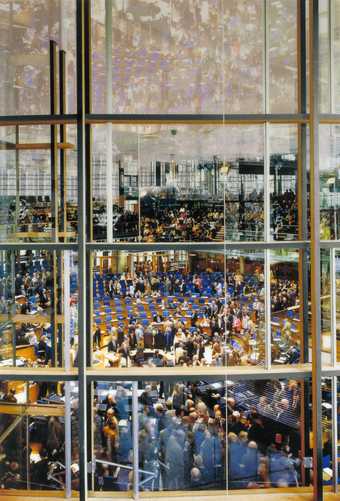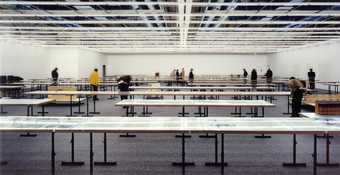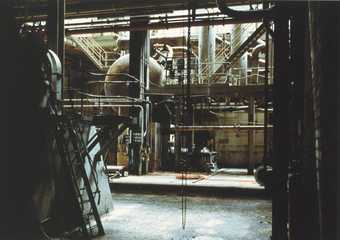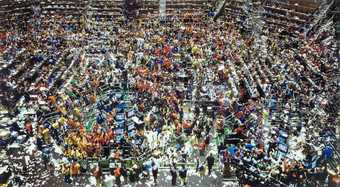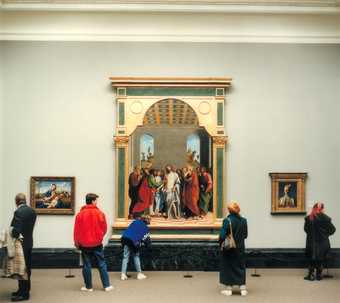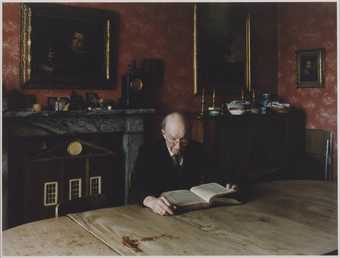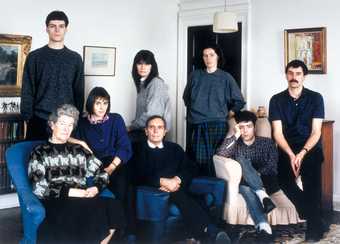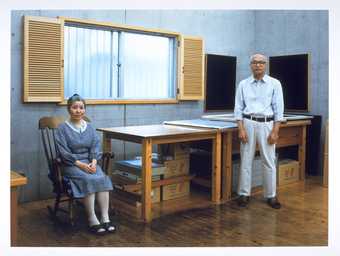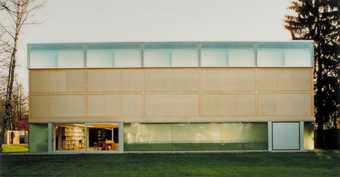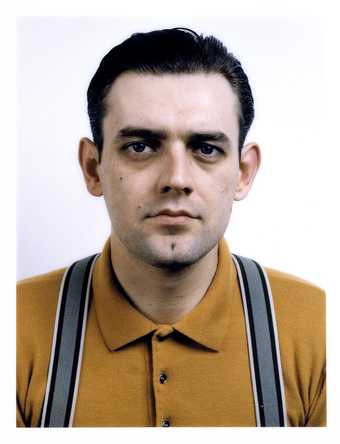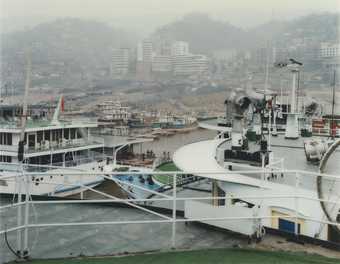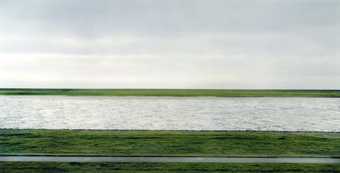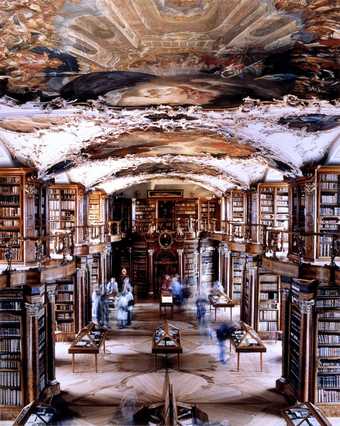
Not on display
- Artist
- Andreas Gursky born 1955
- Medium
- Photograph, colour, on paper
- Dimensions
- Support: 2800 × 1975 mm
- Collection
- Tate
- Acquisition
- Purchased with funds provided by David Roberts 2007
- Reference
- P79322
Summary
Bahrain I 2005 is a very large portrait format colour photograph by the German artist Andreas Gursky of the Bahrain International Circuit, a motorsport race track completed in 2004 that hosts the country’s annual Formula One Grand Prix. Taken from a helicopter and subsequently manipulated using digital software, the photograph shows the track curving in a snake-like fashion through the desert landscape, the black asphalt forming a strong contrast with the beige sand surrounding it. No cars or people are visible in the image, although a long horizontal grandstand with a white roof can be seen just above the centre of the composition. A cluster of distant buildings are also perceptible near the horizon underneath a hazy grey-blue sky. Tate’s copy is number one in an edition of six (plus an artist’s proof).
This work is related to another image of the same race track made by Gursky, Bahrain II 2007 (reproduced in Gagosian Gallery 2010, vol.2, p.27), which provides a closer aerial view of just three elements of the circuit. The images of the Bahrain track were created by Gursky while he was working on a larger series inspired by motor racing, F1 Boxenstopp (F1 Pit Stop), completed in 2007, which features panoramic images of Formula One cars and their colourfully-suited support teams taken at races around the world.
Gursky, whose father and grandfather were also photographers, was trained between 1981 and 1987 at the Arts Academy in Düsseldorf, the city where he continues to live and work. During his studies he was taught by the German photographers Bernd (Bernhard) Becher (1931–2007) and Hilla Becher (born 1934). The objective and systematic approach to photographing industrial structures that the Bechers emphasised in their own work (see, for example, Coal Bunkers 1974, Tate T01923) proved highly influential on Gursky and a wider group of photographers at the Arts Academy, including Candida Höfer and Thomas Ruff, who studied alongside Gursky, and Thomas Struth and Axel Hütte, who completed their studies there in 1980. These photographers have become known collectively as the Düsseldorf School of Photography. Discussing Bahrain II, Gursky has claimed, ‘in terms of composition it comes from the influence of Hilla and Bernd Becher: it has a central perspective and it is photographed from an elevated position – and this is the way that I often approach my subjects’ (quoted in Lane 2009, p.36).
The curvilinear pattern created by the race track and the almost two-tone colouring of Bahrain I draws attention to the formal and compositional choices Gursky made to produce an image that appears almost abstract. As curator Fiona Bradley observed in 1995, Gursky’s images ‘seem first of all to make patterns which speak some universal language or visual or pictorial structures which we have lodged in our minds. Looking at them is an activity of recognising, or perhaps misrecognising, these structures’ (Fiona Bradley, ‘Introduction’, in Andreas Gursky: Images, exhibition catalogue, Tate Liverpool, London 1995, p.10).
Gursky began to digitally alter his photographs in 1991; initially using computers as a tool for retouching images (Restaurant, St. Moritz 1991 was the first work altered in this way), he later used digital technology to combine multiples shots in one image. From the 1990s onwards, after focusing his attention on photographing places in Germany and neighbouring countries, Gursky began to take photographs of locations from around the world and started to print his images on a larger scale. His work has often examined the relationship between humans and their surroundings, particularly in the context of changes brought about by globalisation. The subject of Bahrain I exemplifies this concern in that it highlights the way in which an otherwise lifeless desert landscape has been expensively reshaped to accommodate an affluent, itinerant market. Many of the artist’s photographs adopt a similar bird’s-eye view to that employed in Bahrain I, and depict a small number of people who appear to be dwarfed either by massive natural features (such as mountains) or, more commonly, huge man-made constructions (such as bridges, apartment buildings or industrial sites). In his subsequent work, such as the 2010 Ocean series, Gursky has begun to work with satellite images, which offer an even wider perspective on the landscape.
Further reading
Peter Galassi, Andreas Gursky, exhibition catalogue, Museum of Modern Art, New York 2001.
Guy Lane, ‘Andreas Gursky: The Bigger Picture’, Art World, no.10, April/May 2009, pp.34–9.
Andreas Gursky, exhibition catalogue, Gagosian Gallery, New York 2010, vol.2, pp.26–8.
Richard Martin
May 2014
Supported by Christie’s.
Does this text contain inaccurate information or language that you feel we should improve or change? We would like to hear from you.
Explore
- architecture(30,960)
-
- places of entertainment(637)
-
- race course(12)
- townscapes / man-made features(21,603)
-
- townscape, distant(8,109)
- formal qualities(12,454)
-
- photographic(4,673)
- countries and continents(17,390)
-
- Bahrain(1)
You might like
-
Andreas Gursky Thebes, West
1993 -
Andreas Gursky Parliament
1998 -
Andreas Gursky Centre Georges Pompidou
1995 -
Thomas Struth Bankside 5, London 1995
1995 -
Andreas Gursky Chicago, Board of Trade II
1999 -
Thomas Struth National Gallery I, London 1989
1989 -
Thomas Struth The Shimada Family, Yamaguchi, Japan 1986
1986 -
Thomas Struth The Late Giles Robertson (with Book), Edinburgh 1987
1987 -
Thomas Struth The Smith Family, Fife, Scotland 1989
1989 -
Thomas Struth Kyoko and Tomoharu Murakami, Tokyo 1991
1991 -
Thomas Ruff Goetz Collection
1994 -
Thomas Ruff Portrait 1986 (Stoya)
1986 -
Thomas Struth Boats at Wushan, Yangtse River
1997 -
Andreas Gursky The Rhine II
1999 -
Candida Höfer Stiftsbibliothek St. Gallen I
2001


